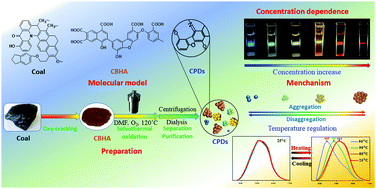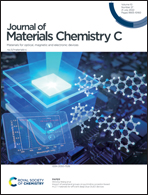Achieving full-color emission in coal-based humic acid derived carbon dots through intradot aggregation†
Abstract
Coal-based humic acid (CBHA) is an ideal precursor for the preparation of carbon materials due to its high aromaticity and abundance of oxygen-containing functional groups. The resulting materials often exhibit unique optical properties due to various intramolecular and intermolecular interactions. In this work, full-color luminescent carbon polymer dots (CPDs) were prepared from CBHA in DMF solvent in an oxygen environment. The results show that the emission of CPDs is concentration-dependent, so that full-color emission in the visible region can be obtained by adjusting the concentration. The solvent thermal oxidation enables the tailoring of the humic acid structure to form molecular state carbon dots with luminescence ability. The molecular state carbon dots then aggregate via non-covalent bonding to form CPDs. The intradot aggregation and disaggregation of molecular state carbon dots are reversible, thus showing a clear concentration dependence. Benefiting from these luminescence properties, a cold white light emission material was successfully achieved. These findings contribute to the understanding of the mechanism of the optical properties of CDs.



 Please wait while we load your content...
Please wait while we load your content...